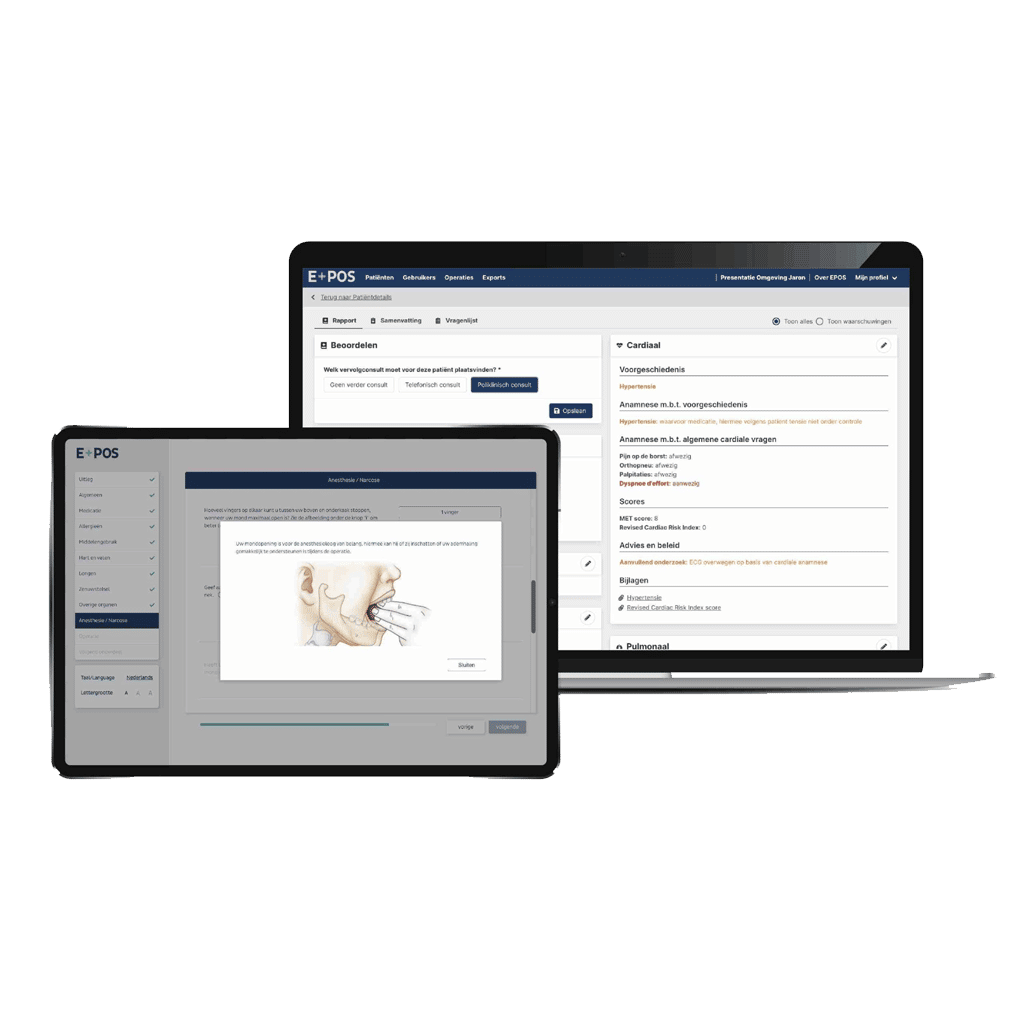How E-POS increases medical questionnaire response rate to 98%
Preoperative screening is critical to ensure patient safety during surgical procedures. Traditionally, this screening has been performed via paper questionnaires. Paper questionnaires are not only time-consuming but also enormously error-prone due to the mix-up of patients during digitization. More and more hospitals are using digital screening solutions, of which E-POS is the leader.
E-POS is a validated screening tool that allows patients to complete a digital questionnaire at home before undergoing surgery. In addition, E-POS informs patients about anesthesia techniques and procedures including the fasting policy. This reduces the need for outpatient visits and frees up time with scarce healthcare providers. Based on scientifically validated algorithms, E-POS advises whether or not a patient should undergo an in-person consultation with an anesthesiologist or can be safely seen on the day of surgery.
Nearly 98% of patients complete the questionnaire
In order to make good use of a questionnaire in the anesthesiology work process, it is important that the response rate is as high as possible. E-POS achieves around 98% in this regard.
This is important because it means physicians have access to more accurate and comprehensive information about patients even before surgery and preoperative consultation. This in turn helps healthcare providers make more informed decisions about a patient's suitability and appropriate follow-up steps.
However, a questionnaire (physical or digital) is useless if patients do not complete it or complete it incompletely. This is how E-POS increases the response rate:
Measure 1: Login method
E-POS Integrates with most patient portals. Usually the response rate of the questionnaire from the portal remains stuck around 55-65%. The highest response rate is achieved by sending the questionnaire via email. Patients receive an SMS code after clicking on the link from the E-POS email to verify that the recipient of the email is actually the patient.
Deliberately choosing e-mail & SMS verification instead of a DIGID login is an important factor. This way the patient does not have to maneuver himself through the patient portal and also the DIGID portal.
Measure 2: Supporting multilingualism
The Netherlands has an upward trend of residents whose first language is not Dutch. The healthcare needs of these groups are often high. The accessibility of digital care, including medical questionnaires, is often relatively small. This is often reflected in the response rate of questionnaires.
Logically, this target group does not sufficiently understand the Dutch and sometimes English questionnaires because of the language or the way questions are worded. For this reason E-POS is designed to make the questionnaire and information videos simple. As a result, patients at Haaglanden MC and Het Dijklander Ziekenhuis use the questionnaire, for example, in Dutch, English, Spanish, Polish, Turkish and Arabic.
During NovaCair's target group survey, it was found that the poor response rate also had a cause other than a language deficiency. In fact, translated questionnaires made available in a patient portal are also not always completed by people with a migration background. This is because while the questionnaire may be translated, the patient portals themselves are usually only available in Dutch and sometimes in English.
This is the reason why many clients choose to offer the questionnaires via email secured with 2-step verification.
Measure 3: Focus on user experience
What is the biggest difference between checking out a Web shop payment and navigating through the average digital medical questionnaire? Exactly ... the user experience.
While people fill out data with ease to buy a product online, many digital questionnaires are often relatively poorly usable and therefore user-unfriendly.
That's because of:
- Poor availability of a mobile or tablet version; (healthcare providers, when purchased, only test the questionnaire on the computer, while over 60% of people complete questionnaires on mobile).
- Enabling forgotten input or unclear indication that a question has been forgotten;
- Poor fill-in for the elderly; (small buttons; lots of scrolling; small font)
NovaCair chose to hire web developers with a background in UX (user experience) at major web shops to develop E-POS . As a result, the questionnaire is equally easy to complete on any browser version and device.
User experience is difficult to explain, but easy to experience for yourself. A test questionnaire can be requested at this link. Please note carefully:
- How it is not possible to forget answering;
- How easy E-POS scrolls on to the next question;
- How the system is available on any cell phone;
In addition, it is also possible at all times to click away from the questionnaire (for when someone is at the door, for example) and then reopen the questionnaire. E-POS stores all answers in the interim, so patients do not have to fill in answers again.
Finally, forgetting to complete a questionnaire is human. Reminding the patient to complete the questionnaire fortunately is not. E-POS offers automatic (SMS and email) reminders if a patient forgets to complete or start the questionnaire.
Conclusion
In summary; the 98% response rate when patients receive the E-POS questionnaire via SMS or email is a key component and benefit of E-POS and demonstrates the effectiveness of the implementation of the software. E-POS helps streamline the preoperative screening process.
Curious about the possibilities for you?
Create test account
It's nice to test E-POS yourself as well. Fill out the form below and request an account.

